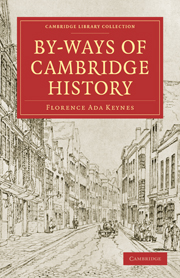Book contents
- Frontmatter
- PREFACE
- Contents
- ILLUSTRATIONS
- Introductory
- Chap. I The Guildhall and the Market Place
- Chap. II The Office of High Steward of the Borough of Cambridge
- Chap. III Cambridge Waits and Orlando Gibbons
- Chap. IV Barnwell Priory and the Old Abbey House
- Chap. V Why Oxford comes First. A Problem in Precedence
- Chap. VI Damaris Cudworth.—A Cambridge Woman of the Seventeenth Century
- Chap. VII A Town Plan for Cambridge in the Eighteenth Century
- Chap. VIII Mendicity House. Sidelights on Social Conditions in Cambridge in the Nineteenth Century
- Appendix: ‘Cambridge’ as a place-name
- Index
- Plate section
- Frontmatter
- PREFACE
- Contents
- ILLUSTRATIONS
- Introductory
- Chap. I The Guildhall and the Market Place
- Chap. II The Office of High Steward of the Borough of Cambridge
- Chap. III Cambridge Waits and Orlando Gibbons
- Chap. IV Barnwell Priory and the Old Abbey House
- Chap. V Why Oxford comes First. A Problem in Precedence
- Chap. VI Damaris Cudworth.—A Cambridge Woman of the Seventeenth Century
- Chap. VII A Town Plan for Cambridge in the Eighteenth Century
- Chap. VIII Mendicity House. Sidelights on Social Conditions in Cambridge in the Nineteenth Century
- Appendix: ‘Cambridge’ as a place-name
- Index
- Plate section
Summary
IT is rash for an amateur to venture upon a field of inquiry long and thoroughly worked by experts. The only excuse I can offer for presuming to write on a quasi-historical subject, lies in the hope that I may succeed in interesting some of those who share my love of Cambridge and desire to know more of her past without having the time or the opportunity to consult authorities for themselves.
My own interest is of long-standing. I came to live in Cambridge on my marriage sixty-four years ago, having been before that time one of the early students at Newnham, then a Hall of residence with rooms for about thirty. Those early students, many of them of mature age, pursued their studies under the more than maternal eye of Miss Anne Jemima Clough. Their kind friends in Cambridge, with Henry Sidgwick as leader, who were deeply interested in providing opportunities for women to obtain University education, were naturally anxious as to the impression they would make in a community where there were many critics. If the movement was to succeed, it must be very cautiously introduced and carefully guided. The task was not an easy one, but if the more emancipated spirits were sometimes irked by restrictions which seemed tiresome and unnecessary, the situation was in the main accepted cheerfully, and it was recognized that the advantages far outweighed the disabilities.
The desire of our Principal, Miss Clough, to whom we owed so much, was that we should be as inconspicuous as possible not only in behaviour but also in appearance, in order not to alarm the doubters—and here some difference of opinion arose.
- Type
- Chapter
- Information
- By-Ways of Cambridge History , pp. xi - xxviPublisher: Cambridge University PressPrint publication year: 2009First published in: 1947

